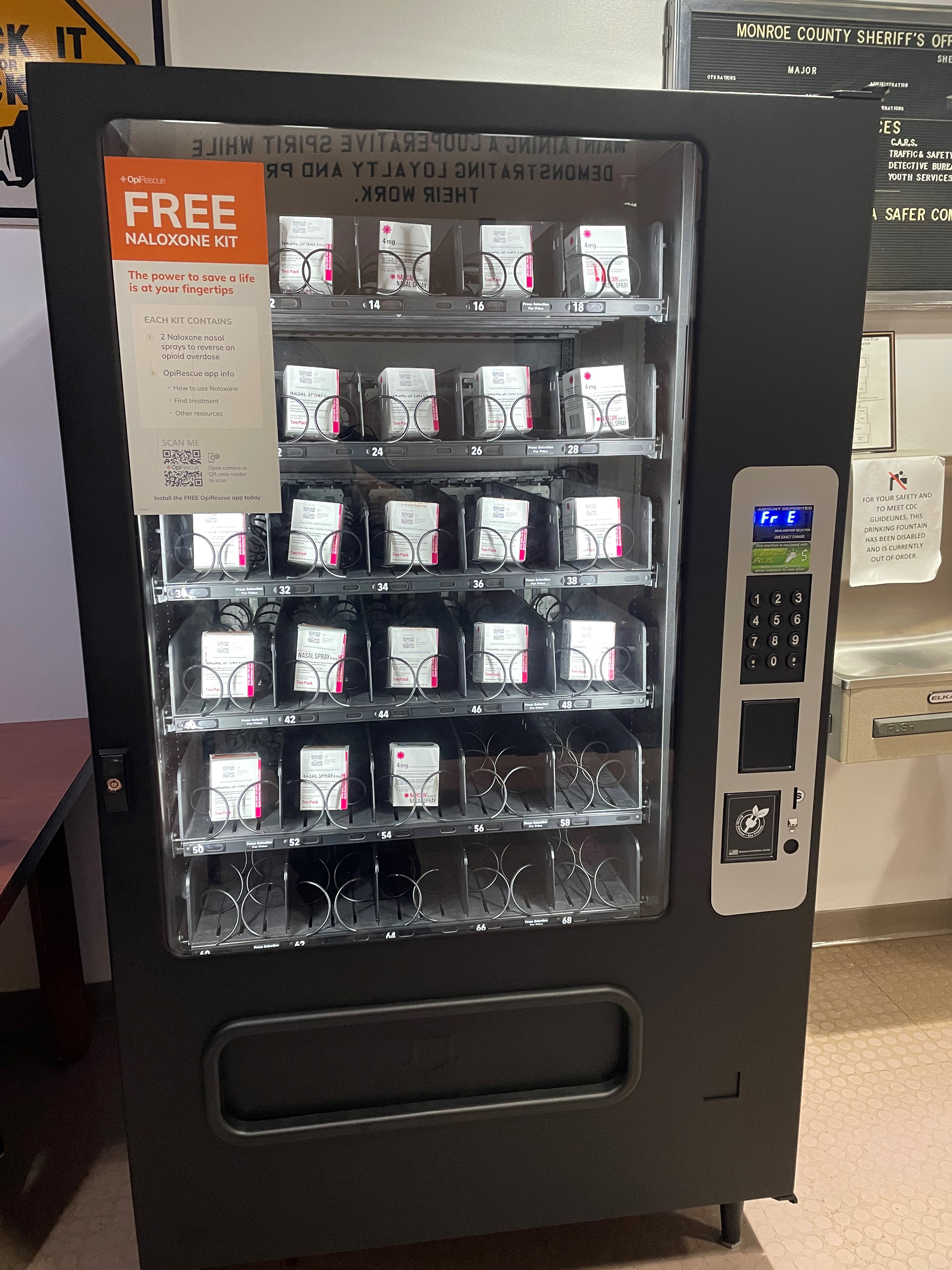Harm reduction based naloxone distribution
 Michigan Overdose Data to Action
Michigan Overdose Data to Action
Naloxone is an opioid antagonist that can be administered intravenously, intramuscularly, subcutaneously or intranasally. It displaces and blocks opioid agonists from receptor sites, effectively reversing an opioid overdose.1 Its effectiveness has been well established,2 with few adverse events following administration.3 Rising rates of opioid-related overdoses have led to growing efforts to distribute naloxone in community settings.4,5

Incarceration has emerged as a life-threatening risk factor for overdose, especially for those with opioid use disorder (OUD). Research from CBHJ suggests that more than one in five overdose deaths in the community are recently released jail detainees.6-10 Jails serve a unique opportunity to intervene for those with OUD to mitigate the risk of death following release;11,12 however, while detainees leaving jail may not have a disorder their peers might use opioids providing an opportunity for them to intervene and reverse an overdose with naloxone.
The CBHJ developed a toolkit to guide jails in building and expanding existing naloxone distribution programs and describe the safety and effectiveness of naloxone, explore strategies to provide overdose prevention training and distribute naloxone kits to jail detainees, and provide resources to procure and track distribution of naloxone kits. In partnership with MODA the CBHJ has been able to pilot a potentially high impact strategy for naloxone distribution: vending machines.
Partnering with local harm reductions agencies and with feedback from persons in active use who are seeking naloxone, we have developed a customized vending machine with Shaffer Distributing out of Livonia, Michigan that can distribute naloxone for free. These machines have the payment mechanism removed and the coils customized for small harm reduction packets that can fit two intranasal naloxone cartridges along with other sanitary and health products. Each vending machine is able to hold 300 naloxone kits.
The harm reduction packets containing naloxone are customized by the specific "stocking agency" who is responsible for refilling the machine. The stockers include harm reduction agencies, community mental health centers, local non-profits, and treatment providers. Research suggests that there is no difference in the ability to successfully reverse an overdose via naloxone among those who have received training and those who have not.13 However, to assure that persons receiving the naloxone are provided with access to training, each naloxone packet also contains information on how to administer naloxone, where to obtain more, and where to access treatment provided via OpiRescue, an online application and website.14


Naloxone vending machines allow free, anonymous access to naloxone and removes the stigma often associated with obtaining naloxone. Through the CBHJ partnerships with jail facilities, and because of the high risk for overdose at release, vending machines have been implemented in several county jail facilities. However, future iterations of these efforts will seek to identify locations where these machines can reach additional high-risk populations. Naloxone is a key tool in the overdose epidemic. Using a harm reduction philosophy, we aim to reduce barriers and respect the rights and autonomy of people who use drugs by meeting them where they are at and supporting any positive change.
References:
- Chou R, Korthuis PT, McCarty D, Coffin PO, Griffin JC, Davis-O'Reilly C, et al. Management of Suspected Opioid Overdose With Naloxone in Out-of-Hospital Settings: A Systematic Review. Annals of Internal Medicine. 2017 Dec 19;167(12):867.
-
Chamberlain JM, Klein BL. A comprehensive review of naloxone for the emergency physician. The American Journal of Emergency Medicine. 1994 Nov 1;12(6):65060.
-
Wermeling DP. Review of naloxone safety for opioid overdose: practical considerations for new technology and expanded public access. Ther Adv Drug Saf. 2015 Feb;6(1):2031.
-
Clark AK, Wilder CM, Winstanley EL. A Systematic Review of Community Opioid Overdose Prevention and Naloxone Distribution Programs. Journal of Addiction Medicine. 2014 Jun;8(3):15363.
-
Naumann RB, Durrance CP, Ranapurwala SI, Austin AE, Proescholdbell S, Childs R, et al. Impact of a community-based naloxone distribution program on opioid overdose death rates. Drug and Alcohol Dependence. 2019 Nov 1;204:107536.
-
Alex B, Weiss DB, Kaba F, Rosner Z, Lee D, Lim S, et al. Death After Jail Release: Matching to Improve Care Delivery. J Correct Health Care. 2017 Jan 1;23(1):837.
-
Binswanger IA. Mortality After Prison Release: Opioid Overdose and Other Causes of Death, Risk Factors, and Time Trends From 1999 to 2009. Ann Intern Med. 2013 Nov 5;159(9):592.
-
Binswanger IA, Stern MF, Deyo RA, Heagerty PJ, Cheadle A, Elmore JG, et al. Release from Prison A High Risk of Death for Former Inmates. New England Journal of Medicine. 2007 Jan 11;356(2):15765.
-
Lim S, Seligson AL, Parvez FM, Luther CW, Mavinkurve MP, Binswanger IA, et al. Risks of Drug-Related Death, Suicide, and Homicide During the Immediate Post-Release Period Among People Released From New York City Jails, 20012005. American Journal of Epidemiology. 2012 Mar 15;175(6):51926.
-
Victor G, Zettner C, Huynh P, Ray B, Sightes E. Jail and Overdose: Assessing the Community Impact of Incarceration on Overdose. Addiction. 2021;
-
Darke S, Larney S, Farrell M. Yes, people can die from opiate withdrawal. Addiction. 2017;112(2):199200.
-
Potter RH, Lin H, Maze A, Bjoring D. Jails and Public Health Service Delivery and Empirical Knowledge: The Impact of Jail Population "Flow." Am J Crim Just. 2012 Jun 1;37(2):2008.
-
Doe-Simkins M, Quinn E, Xuan Z, Sorensen-Alawad A, Hackman H, Ozonoff A, et al. Overdose rescues by trained and untrained participants and change in opioid use among substance-using participants in overdose education and naloxone distribution programs: a retrospective cohort study. BMC Public Health. 2014 Apr 1;14(1):297.
-
OpiRescue [Internet]. OpiSafe. [cited 2021 Jun 29]. Available from: https://opisafe.com/products/opirescue